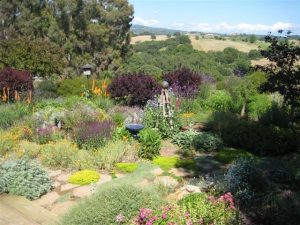Sonora, CA — A long time writer on Tuolumne County Master Gardeners, Carolee James, talks about how she is adapting her landscape to her new home.
I recently moved from Tuolumne County to the town of Oakley in the delta. My new home is in a residential community and I plan to plant my rear garden with all California native plants. Most of the native plants I plan to use are not indigenous to this area. In fact, after some research, I found that my house is located in a part of the valley’s grasslands and, more specifically, in an area that once was delta marshlands. Native plants normally found in this region are wildflowers, needlegrasses (Stipa and Nasella species), rushes (Juncus species), sedges (Carex species) and a few species of shrubs.
My garden will be planted with a collection of native trees, shrubs, grasses, vines, ferns, and perennials. The experiment is to see how they will adapt to the soil and weather conditions of this low elevation. Even though this area is still considered a Mediterranean-type climate (dry summers, cool, wet winters), the microclimate is very different from that of the foothills due to the close proximity to the delta. I have also found that the man-made lake two blocks from my house seems to create a perpetual dampness in the air.
I am designing the back garden based on the plants that I have and the look I want to achieve. The yard faces south so there will be little to no shade until the trees and shrubs get some height. Along with the native plants, I have incorporated my collection of fourteen Japanese maple trees (all to stay in containers) as part of the design.
Along the fence on either side are holly-leaf cherry shrubs (Prunus ilicifolia), and across the back fence are coffeeberry shrubs (Rhamnus tomentella). All of these shrubs will be allowed to grow to their maximum size of over eight feet tall and six feet wide.
Other shrubs waiting to be planted are: western spice bush (Calycanthus occidentalis), western serviceberry (Amelanchier alnifolia), Sierra current (Ribes nevadense), mountain spirea (Spirea densiflora), Oregon grape (Mahonia aquifoilum), wooley blue curls (Trichostema lanatum), and snowbell bush (Styrax officinallis). Also waiting are: small-leafed cream bush (Holodiscus microphyllus), oso berry bush (Osmarnia cerasiformis), western redbud (Cercis occidentalis), red-twig dogwood (Cornus stolonifera ‘Isanti’), flannel bush (Fremontodendron ‘San Gabriel’), coyote bush (Baccharis pilularis), and California wood rose (Rosa californica).
Perennials will include Cleveland sage (Salvia clevelandii ‘Bee’s Bliss’ and ‘Whirley Blue’), hummingbird sage (Salvia spathacea), soap plant (Chlorogalum pomeridianum), California fuschia (Zauschneria species ‘Wayne’s Silver’, ‘Catalina’ and ‘Select Matthole’), Penstemon (Penstemon heterophyllis ‘Margaret BOP’), and sulfur buckwheat (Eriogonum umbellatum).
I’ve gone a little crazy with the grasses that will act as fillers, such as red fescue ‘Molate’ (Festuca rubra), a spreading grass for my canine kids to play on. For spillers, I will plant Siskiyou Blue Fescues (Festuca idahoensis) to line the walkway; for thrillers, Pacific reed grasses (Calamagrostis nutkaensis) to snake through and across the garden. Oh, and let’s not forget a few slender sedges (Carex tumulicola) tucked in here and there.
Three desert willow trees (Chilopsis linearis) will be planted to provide some shade for the windows facing the back yard. Scattered about the garden will be groups of pots of cliff-maids (Lewisii cotyledon). These wonderful spring-blooming native succulents are just the best plant ever to brighten any garden. A California wild grape (Vitis californica ‘Rogers Red’) will be planted on one of the side fences for beautiful fall color.
Last, but not least, between the fence and the side yard cement walkway, I will tuck in western sword fern (Polystichum munitum), deer fern (Blechnum spicant), and coral bells (Heuchera).
There are so many more plants that I would like to add, but I think you can see I am starting off with quite a variety. Is this the right place for all these plants? I’m not sure, but I’m willing to see what does and doesn’t work in this new garden. Updates on the garden experiment will be forthcoming once a quarter throughout this year.
Carolee is a Master Gardener who will be writing articles on the progress of her new garden near the delta.


